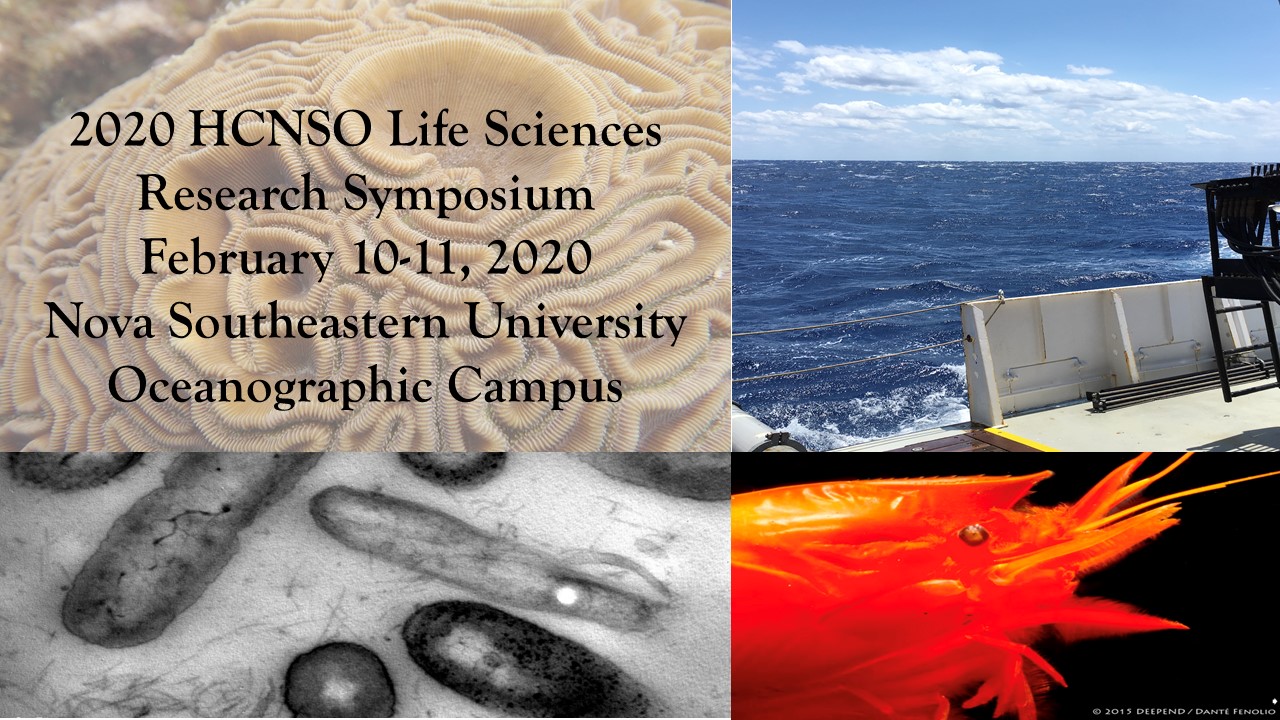Investigating Spatiotemporal Trends of Coral Disease and Mortality Hot Spots along the Florida Reef Tract
Location
HCNSO Guy Harvey Oceanographic Center Nova Southeastern University
Start
2-11-2020 1:30 PM
End
2-11-2020 1:45 PM
Type of Presentation
Oral Presentation
Abstract
Investigating Spatiotemporal Trends of Coral Disease and Mortality Hot Spots along the Florida Reef Tract
Fromuth, L.*; Walker, B. K.
Halmos College of Natural Sciences and Oceanography, Nova Southeastern University
Coral reefs are experiencing severe declines worldwide due to stress from anthropogenic impacts and increased mortality from disease. The Caribbean is most impacted, containing the largest proportion of corals in high extinction-risk categories. Disease prevalence is low (<5%) in healthy coral populations, while elevated levels of disease are associated with pollution from sewage outfalls, runoff, and thermal stress. Given that the magnitude of these factors can differ across the seascape, we performed a cluster analysis on FRT-wide coral data to determine areas where disease and mortality prevalence were consistently higher. Thirteen years of coral bleaching and disease data on Florida’s Coral Reef were analyzed using the Getis-Ord Gi* statistic by year within two broad regions; Southeast Florida and the Florida Keys. Results were then combined and separated into two groups to illustrate trends in prevalence occurring both before the disease event (2011 – 2013) and during the disease event (2014 – 2016). Analyses indicated that reefs in Broward and Miami-Dade counties, Key Largo, and Key West were statistically significant hot spots of disease prevalence for many years; both before and after the current disease event that has proliferated since late 2014. Reefs in Broward County, and the Upper Keys and Lower Keys were statistically significant hot spots for mortality prevalence, with the most frequent clustering occurring in the Upper Keys region. The areas exhibiting statistically significant higher disease and mortality prevalence compared to surrounding reefs coincide with high population centers and highly used and managed waterways. More investigation is needed into these spatial associations.
Presenting author’s contact: ef611@mynsu.nova.edu
Investigating Spatiotemporal Trends of Coral Disease and Mortality Hot Spots along the Florida Reef Tract
HCNSO Guy Harvey Oceanographic Center Nova Southeastern University
Investigating Spatiotemporal Trends of Coral Disease and Mortality Hot Spots along the Florida Reef Tract
Fromuth, L.*; Walker, B. K.
Halmos College of Natural Sciences and Oceanography, Nova Southeastern University
Coral reefs are experiencing severe declines worldwide due to stress from anthropogenic impacts and increased mortality from disease. The Caribbean is most impacted, containing the largest proportion of corals in high extinction-risk categories. Disease prevalence is low (<5%) in healthy coral populations, while elevated levels of disease are associated with pollution from sewage outfalls, runoff, and thermal stress. Given that the magnitude of these factors can differ across the seascape, we performed a cluster analysis on FRT-wide coral data to determine areas where disease and mortality prevalence were consistently higher. Thirteen years of coral bleaching and disease data on Florida’s Coral Reef were analyzed using the Getis-Ord Gi* statistic by year within two broad regions; Southeast Florida and the Florida Keys. Results were then combined and separated into two groups to illustrate trends in prevalence occurring both before the disease event (2011 – 2013) and during the disease event (2014 – 2016). Analyses indicated that reefs in Broward and Miami-Dade counties, Key Largo, and Key West were statistically significant hot spots of disease prevalence for many years; both before and after the current disease event that has proliferated since late 2014. Reefs in Broward County, and the Upper Keys and Lower Keys were statistically significant hot spots for mortality prevalence, with the most frequent clustering occurring in the Upper Keys region. The areas exhibiting statistically significant higher disease and mortality prevalence compared to surrounding reefs coincide with high population centers and highly used and managed waterways. More investigation is needed into these spatial associations.
Presenting author’s contact: ef611@mynsu.nova.edu


